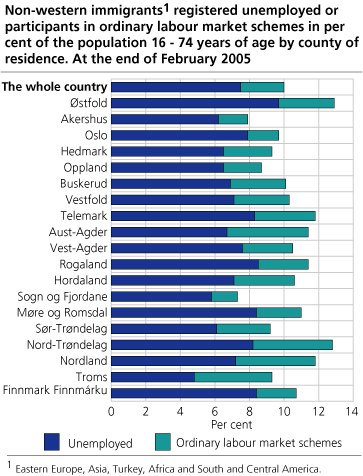Content
Published:
This is an archived release.
Unemployment among immigrants reduced
The unemployment rate among immigrants decreased by 0.3 percentage points, from 10.3 per cent in February 2004 to 10.0 per cent in February 2005. In the whole population the decline in percentage points was the same, from 4.1 to 3.8 per cent. All figures are calculated as a fraction of the labour force.
An immigrant is in these statistics defined as a first-generation immigrant, i.e. a person born abroad by foreign-born parents. He or she is also registered as settled in Norway for at least 6 months.
A slight decrease in the unemployment rate is recorded in most immigrant groups, western as well as non-western, last year. The only exception is to be found among immigrants from South- and Central America whose unemployment rate remained stable. Immigrants from Eastern Europe had the strongest decrease by 0.7 percentage points.
Decrease among men only
Only men experienced the decrease in unemployment rate - within the whole population and among immigrants - by 0.5 and 0.8 percentage points respectively. In total among women a slight increase of 0.1 percentage point was recorded, while immigrant women had an increase of 0.2 percentage point. Despite these tendencies, men had still the highest registered unemployment rate, 4.1 versus 3.5 per cent in the whole population and 10.9 versus 9.0 per cent among immigrants.
The new EU countries
Immigrants from the new EU countries in Eastern Europe had in total an unemployment rate of 5.9 per cent at the end of February 2005, while immigrants from the other eastern European countries had a rate twice as high - 12.0 per cent. In other words, immigrants from the new EU countries experienced an unemployment rate at the level of the western immigrant group from North America and Oceania in the first quarter.
More than 18 per cent unemployed Africans
Immigrants from Africa had the highest unemployment rate at 18.6 per cent in February 2005, while immigrants from Asia had 13.2 per cent. The immigrants from Eastern Europe and South and Central America had rates almost at the same level, 10.3 and 11.2 per cent respectively. Immigrants from the Nordic countries had as usual the lowest unemployment rate at 4.5 per cent closely followed by the other western European immigrants at 4.7 per cent. Unemployment among immigrants from North America and Oceania came to 5,8 per cent. This is, however, the smallest immigrant group consisting of only 240 recorded unemployed.
The high unemployment rate among African immigrants must be seen in connection to the relative high portion of newcomers within this group, especially refugees from Somalia.
Highest unemployment from 4 to 7 years of residence
The highest unemployment rate was recorded among immigrants with a time of residence of 4 until 7 years, which was 3.1 percentage points higher than among those with a shorter time of residence, 9.4 versus 6.3 per cent (in per cent of the population aged 16-74 years). This difference is most likely due to the fact that many newcomers among the non-western immigrants - mostly refugees - are occupied with language- and job training before entering the labour force as registered job-seekers. Among immigrants with 7 years of residence or more the unemployment rate decreased, to 5.7 per cent.
Labour market schemes
The number of immigrants on ordinary labour market schemes (job programmes) decreased from
6 241 in February 2004 to 5 050 in February 2005. These people accounted for 28 per cent of all participants on such schemes last quarter and included mainly non-westerners.
As a percentage of the immigrant population, participation on labour market schemes decreased from 2.4 per cent to 1.9 per cent. In the whole population the participant rate decreased slightly from 0.6 per cent to 0.5 per cent.
Immigrants from Africa had the highest participant rate in February 2005 at 3.4 per cent. Immigrants from Asia and Eastern Europe had participation rates at 2.5 and 2.2 per cent respectively.
Tables:
- Table 1 Registered unemployed aged 16-74 years, by region of birth and sex. By the end of November 2003, February 2004, November 2004 and February 2005. In absolute figures and per cent of the labour force
- Table 2 Participants in ordinary labour market schemes (job programmes), by region of birth and sex. By the end of November 2003, February 2004, November 2004 and February 2005. In absolute figures and per cent of persons aged 16-74 years
- Table 3 Registered unemployed and participants in ordinary labour market schemes (job programmes), by region of birth and time of residence in Norway. By the end of February 2004 and 2005. In per cent of persons in total aged 16-74 years
- Table 4 Registered unemployed, by region of birth and county of residence. By the end of February 2004. Absolute figures and in per cent of persons in total 16-74 years
- Table 5 Registered unemployed, by region of birth and county of residence. By the end of February 2005. Absolute figures and in per cent of persons in total 16-74 years
- Table 6 Registered participants in ordinary labour market schemes, by region of birth and county of residence. By the end of February 2005. Absolute numbers and in per cent of persons in total 16-74 years
- Table 7 Registered unemployed first generation immgrants from Eastern Europe, by EU status of the country of birth. By the end of February 2004 and 2005. Absolute figures and in per cent of the labour force
Additional information
The unemployment figures are based on the Norwegian Labour and Welfare Organisation’s register of jobseekers and are calculated as a share of the labour force, which is the sum of employed persons and registered unemployed persons, i.e. people offering their labour on the labour market.
Contact
-
Statistics Norway's Information Centre
E-mail: informasjon@ssb.no
tel.: (+47) 21 09 46 42

